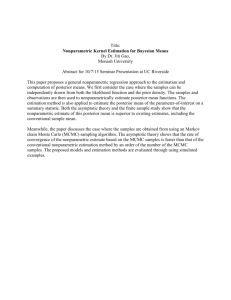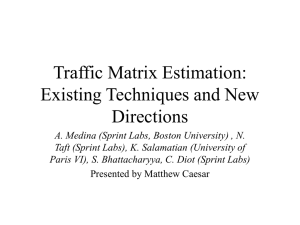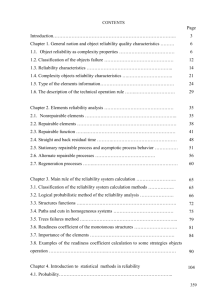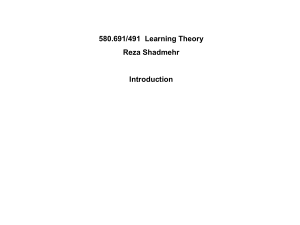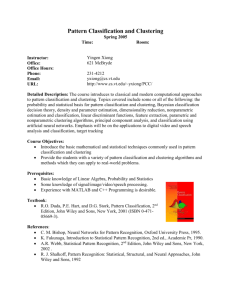ROCHESTER INSTITUTE OF TECHNOLOGY
advertisement
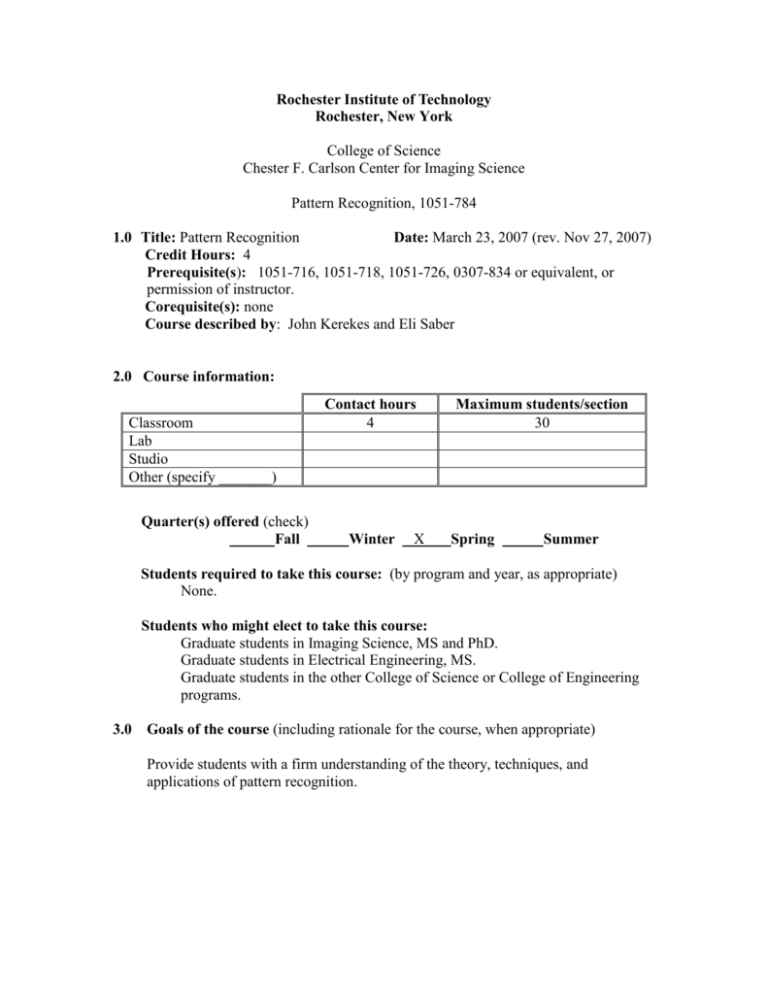
Rochester Institute of Technology Rochester, New York College of Science Chester F. Carlson Center for Imaging Science Pattern Recognition, 1051-784 1.0 Title: Pattern Recognition Date: March 23, 2007 (rev. Nov 27, 2007) Credit Hours: 4 Prerequisite(s): 1051-716, 1051-718, 1051-726, 0307-834 or equivalent, or permission of instructor. Corequisite(s): none Course described by: John Kerekes and Eli Saber 2.0 Course information: Classroom Lab Studio Other (specify _______) Quarter(s) offered (check) Fall Contact hours 4 Winter X Maximum students/section 30 Spring Summer Students required to take this course: (by program and year, as appropriate) None. Students who might elect to take this course: Graduate students in Imaging Science, MS and PhD. Graduate students in Electrical Engineering, MS. Graduate students in the other College of Science or College of Engineering programs. 3.0 Goals of the course (including rationale for the course, when appropriate) Provide students with a firm understanding of the theory, techniques, and applications of pattern recognition. 4.0 Course description (as it will appear in the RIT Catalog, including pre- and corequisites, quarters offered) 1051-784 Pattern Recognition This course develops a fundamental understanding of adaptive pattern recognition and a basic working knowledge of techniques for use in a broad range of applications. Inherent in adaptive pattern recognition is the ability of the system to learn by supervised or unsupervised training, or by competition within a changing environment. The effectiveness of the system depends upon its structure, adaptive properties and specifics of the application. Particular structures developed and analyzed include Bayes decision theory, parametric and nonparametric techniques, multilayer perceptrons and unsupervised clustering methods. The goal is to gain both a fundamental and working knowledge of each kind of technique and the ability to select the most appropriate one when faced with a real application design. Also offered online. (1051-716, 1051-718, 1051-726, and 0304-834 or equivalents) Class 4, Credit 4 (S) 5.0 Possible resources (texts, references, computer packages, etc.) 5.1 S. Theodoridis and K. Koutroumbas, Pattern Recognition, Academic Press 5.2 Duda, Hart, and Stork, Pattern Classification, Wiley-Interscience 5.3 Instructor’s Course Notes. 6.0 Topics 6.1 Introduction to Pattern Recognition 6.1.1 Pattern recognition systems 6.1.2 Examples of applications 6.1.3 Basic probability review 6.1.4 Linear mathematics review 6.2 Bayesian Decision Theory 6.2.1 Bayesian decision making 6.2.2 Classifiers, discriminant functions, and decision surfaces 6.2.3 Normal distribution 6.3 Parameter Estimation 6.3.1 Maximum likelihood estimation 6.3.2 Maximum a posteriori estimation 6.3.3 Bayesian estimation 6.4 Nonparametric Techniques 6.4.1 Density estimation 6.4.2 Parzen windows 6.4.3 k-nearest neighbor estimation 6.4.4 k-nearest neighbor classification 6.5 Linear Discriminant Functions 6.5.1 Linear discriminant functions and decision surfaces 6.5.2 Perceptron algorithm 6.5.3 Least squared error procedures 6.5.4 Support vector machines 6.6 Nonlinear Classifiers 6.6.1 Multilayer perceptrons (neural networks) 6.6.2 Backpropagation algorithm 6.6.3 Generalized linear classifiers 6.6.4 Decision trees 6.6.5 Combining classifiers 6.7 Feature Selection 6.7.1 Data preprocessing 6.7.2 Selection based on statistical hypothesis testing 6.7.3 Class separability measures 6.7.4 Optimal feature selection 6.8 Feature Transformation 6.8.1 Basis vectors 6.8.2 Karhunen-Loeve transform 6.8.3 Independent component analysis 6.8.4 Shape features (moments, Fourier, fractals) 6.9 Template Matching 6.9.1 Correlation classifiers 6.9.2 Criterion functions 6.10 System Evaluation 6.10.1 Error counting 6.10.2 Error bounds 6.11 Unsupervised Clustering 6.11.1 Basic concepts 6.11.2 Distance metrics 6.11.3 Isodata algorithm 6.11.4 Special clustering topics 7.0 Intended learning outcomes and associated assessment methods of those outcomes Learning Outcome 7.1 Knowledge of various types of pattern recognition algorithms and best when to apply each technique 7.2 Ability to apply parameter estimation techniques to pattern recognition situations 7.3 Knowledge of error probabilities, bounds and accuracy estimation In class attendance and evaluation X Homework Assignments, Projects, and Exams X X X X X 8.0 Program or general education goals supported by this course 8.1 Satisfies one elective course requirement for MS or PhD in Imaging Science, or MS in Electrical Engineering. 8.2 Prepares graduate students in science and engineering for careers in fields using pattern recognition techniques. 9.0 Other relevant information (such as special classroom, studio or lab needs, special scheduling, media requirements, etc.) 9.1 Classroom with computer projection system. 10.0 Supplemental information - NONE






